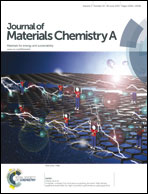Interconnected TiOx/carbon hybrid framework incorporated silicon for stable lithium ion battery anodes†
Abstract
Silicon is one of the most promising anode materials for lithium ion batteries due to its high-specific capacity. However, its poor cycling stability and rate capability limit its practical use. Herein, we report the scalable fabrication of a unique three-dimensional porous silicon/TiOx/carbon (Si/TiOx/C, 0 < x < 2) binder free composite electrode for lithium ion batteries. The TiOx/C frameworks were incorporated by a slurry coating method followed by heat treatment, resulting in a well-connected three dimensional framework structure consisting of Si nanoparticles conformably embedded in the conducting TiOx/C matrix. The porous TiOx/C conductive framework effectively alleviates the volume change of Si during cycling and substantially improves the structural stability of electrode materials. Moreover, the amorphous TiOx/C conductive matrix provides high electrical conductivity and facilitates the electrochemical reaction between Li and Si. As a consequence, the Si/TiOx/C electrode exhibits a stable reversible specific capacity of 1696 mA h g−1 at 0.1 A g−1 after 100 cycles with 87% capacity retention and superior rate capability (754 mA h g−1 at 15 A g−1). The exceptional performance of the Si/TiOx/C electrode combined with the facile synthesis technique makes it promising for high energy lithium ion batteries.


 Please wait while we load your content...
Please wait while we load your content...